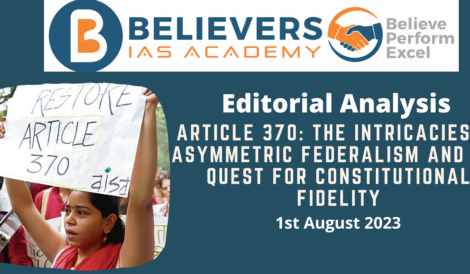Fiscal Federalism
Context:
Kerala Chief Minister Pinarayi Vijayan leads a protest in New Delhi against financial constraints imposed by the Centre, accusing it of pushing the state into a severe financial crisis.
Relevance:
GS – 03, GS – 02 (Mobilization of Resources, Federalism, Co-operative Federalism)
Prelims:
Finance Commission, GST, GST council, Integrated GST, Vertical and Horizontal devolution, Input tax credit, Article 275, GST compensation
Background:
- Kerala moves the Supreme Court, arguing that the Centre’s imposition of a Net Borrowing Ceiling (NBC) violates Article 293 of the Constitution, leading to concerns about fiscal federalism.
- The Net Borrowing Ceiling (NBC) limits states’ borrowings from all sources, including open market borrowings, with Kerala particularly troubled by the inclusion of debt from state-owned enterprises.
- The Centre’s decision to include extra-budgetary borrowings by state-owned enterprises in the total debt of the state raises constitutional concerns, as the power to legislate on public debt falls within the domain of the State Legislature.
- Kerala’s fiscal responsibility targets, outlined in the Kerala Fiscal Responsibility Act, 2003, aim to reduce the fiscal deficit, but restrictions imposed by the Centre hinder the state’s ability to fund welfare schemes and infrastructure projects, potentially leading to a catastrophic situation.
Dimensions of the Article:
- Fiscal Federalism Explained
- Rationale for Revisiting India’s Fiscal Federalism
- Enhancing India’s Fiscal Federalism
Fiscal Federalism Explained:
- Fiscal federalism involves the financial interactions between the Union Government and state governments, focusing on how expenditure and revenue are distributed across various levels of government.
Rationale for Revisiting India’s Fiscal Federalism:
- Evolving Fiscal Landscape: India’s fiscal framework has evolved significantly, transitioning from a planned economy to a market-driven structure, along with the adoption of multi-tier fiscal arrangements post-constitutional amendments and the implementation of reforms like the FRBM Act and GST.
- Complex Intergovernmental Fiscal Relationships: The complexity arises from regional disparities in ethnicity, societal dynamics, and economic conditions, leading to vertical imbalances between state expenditure and revenue. Despite revenue-sharing agreements and central grants, deficits persist.
- Growing Demand for Fiscal Autonomy: States are increasingly seeking greater fiscal autonomy amidst economic transformation and evolving governance structures, necessitating a comprehensive reassessment of fiscal federalism.
Enhancing India’s Fiscal Federalism:
- Equitable Intergovernmental Transfers: Develop fair mechanisms to distribute financial resources between the Union Government and state governments, ensuring that funds are allocated based on objective criteria like population size and economic conditions to promote transparency and accountability.
- Address Horizontal and Vertical Imbalances: Mitigate disparities among states and between central and state governments in terms of revenue and expenditure responsibilities by devising balanced devolution formulas that consider the unique challenges faced by each region.
- Introduce Performance-Based Grants: Implement grants linked to specific developmental targets such as improvements in health and education outcomes, incentivizing states to focus on effective governance and achieve desired results.
- Constitutional Reforms: Streamline governance mechanisms by reviewing relevant articles and schedules in the constitution to clarify the division of powers between the central and state governments, empowering both levels of government to operate efficiently.
- Empower Local Governments: Strengthen grassroots-level institutions by providing adequate resources, functions, and autonomy to municipalities and panchayats, enabling them to address local development needs and promote citizen participation.
- Implement Uniform Financial Reporting: Establish a standardized financial reporting system across government levels to enhance transparency and accountability in fiscal management, ensuring accurate recording and reporting of all financial transactions to facilitate informed decision-making.




